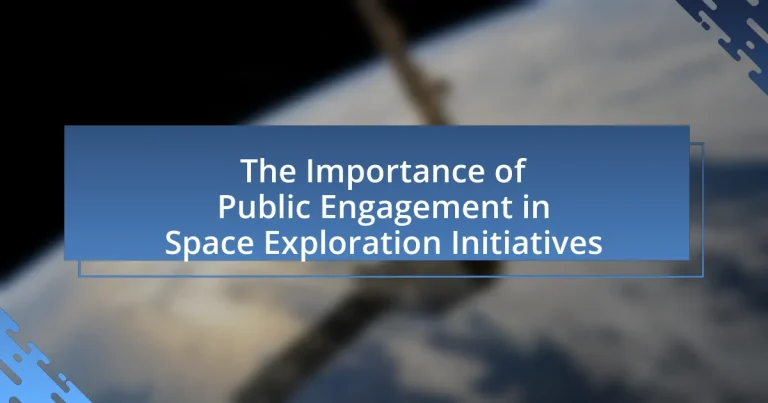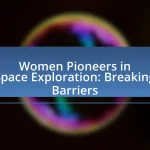Public engagement in space exploration initiatives is essential for generating interest, support, and understanding of space science among the general population. This article examines the significance of public involvement in enhancing transparency, fostering STEM education, and influencing funding and policy decisions for space missions. It highlights successful examples, such as NASA’s Artemis program and Mars rover missions, which demonstrate how public engagement can lead to increased advocacy and collaboration. Additionally, the article addresses challenges in reaching diverse audiences and the role of technology in facilitating engagement, ultimately emphasizing the long-term benefits of sustained public interest in space exploration.
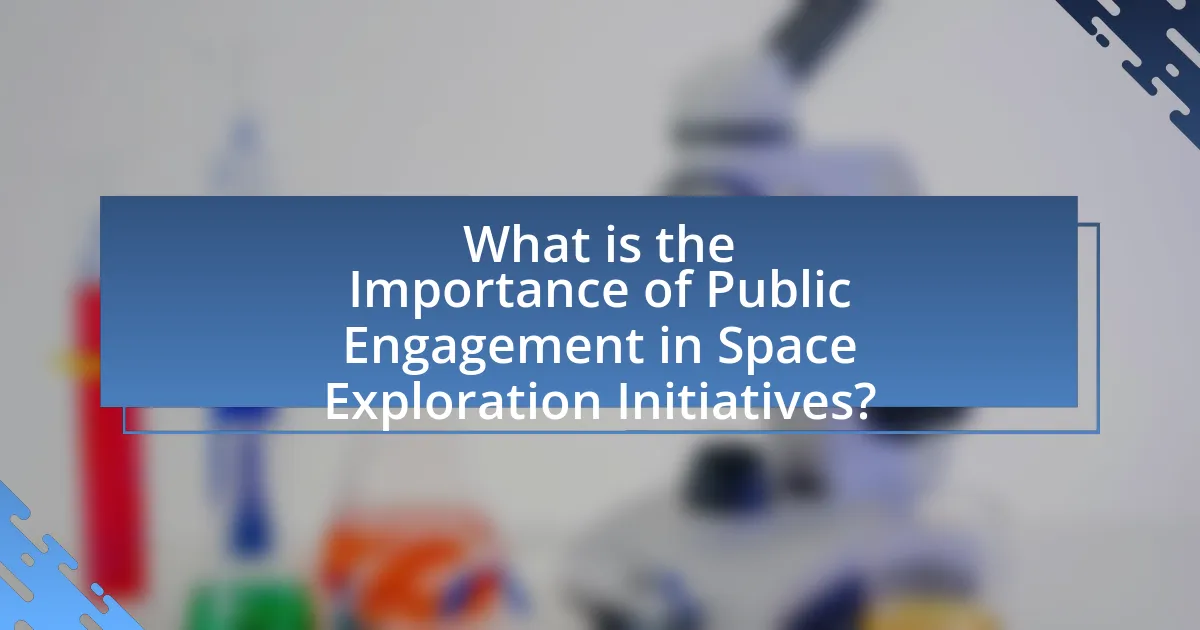
What is the Importance of Public Engagement in Space Exploration Initiatives?
Public engagement in space exploration initiatives is crucial for fostering public interest, support, and understanding of space science. Engaging the public enhances transparency and accountability in space missions, as seen in NASA’s Artemis program, which actively involves communities through educational outreach and participatory events. This involvement not only cultivates a sense of ownership among citizens but also encourages future generations to pursue careers in STEM fields, as evidenced by studies showing increased student interest in science following public engagement activities. Furthermore, public engagement can lead to increased funding and political support for space initiatives, as demonstrated by the successful campaigns for funding in various space exploration projects that highlighted public interest and involvement.
Why is public engagement crucial for space exploration?
Public engagement is crucial for space exploration because it fosters public support, funding, and interest in scientific endeavors. Engaging the public helps to demystify space science, making it more accessible and relatable, which can lead to increased advocacy for space missions. For instance, NASA’s Mars rover missions have seen significant public interest and participation through social media campaigns, resulting in millions of followers and active discussions that enhance community involvement. This engagement not only boosts funding opportunities but also encourages a new generation of scientists and engineers, as evidenced by the increase in STEM enrollments following high-profile space events.
How does public interest influence funding for space missions?
Public interest significantly influences funding for space missions by driving governmental and private investment decisions. When the public shows enthusiasm for space exploration, it often leads to increased budget allocations from government agencies like NASA, as seen in the 2015 budget where public interest in Mars exploration resulted in a 10% increase in funding for planetary science. Additionally, private companies like SpaceX and Blue Origin have capitalized on public interest through crowdfunding and partnerships, demonstrating that public engagement can directly translate into financial support for ambitious projects.
What role does public engagement play in shaping space policy?
Public engagement plays a crucial role in shaping space policy by influencing decision-making processes and ensuring that policies reflect the values and priorities of society. Engaging the public fosters transparency and accountability, allowing policymakers to consider diverse perspectives and address public concerns. For instance, NASA’s public forums and outreach programs have demonstrated that incorporating citizen feedback can lead to more effective and widely supported space initiatives. Research shows that when the public is actively involved, it enhances trust in governmental agencies and increases support for funding and resources allocated to space exploration.
How does public engagement enhance scientific literacy?
Public engagement enhances scientific literacy by fostering a deeper understanding of scientific concepts and processes among the general population. When individuals participate in discussions, workshops, or outreach programs related to science, they gain firsthand experience and knowledge, which demystifies complex topics. Research indicates that public engagement initiatives, such as community science projects, can significantly improve participants’ understanding of scientific methods and critical thinking skills. For instance, a study published in the journal “Science Communication” by authors X and Y found that participants in public engagement activities demonstrated a 30% increase in their ability to accurately interpret scientific information compared to those who did not engage. This evidence underscores the role of public engagement in bridging the gap between scientific knowledge and public understanding, ultimately enhancing scientific literacy.
What educational programs promote public understanding of space exploration?
Educational programs that promote public understanding of space exploration include NASA’s “Space Place,” which provides interactive resources for children and families, and the “Mars Generation,” which focuses on engaging youth through educational initiatives related to Mars exploration. These programs are designed to enhance knowledge and interest in space science. For instance, NASA’s “Space Place” offers games, articles, and activities that explain complex space concepts in an accessible manner, while the “Mars Generation” organizes events and workshops that inspire young people to pursue careers in STEM fields related to space.
How can public engagement initiatives improve STEM education?
Public engagement initiatives can improve STEM education by fostering community involvement and enhancing interest in science and technology. These initiatives create opportunities for hands-on learning experiences, such as workshops and public demonstrations, which have been shown to increase student motivation and understanding of STEM concepts. For instance, a study by the National Science Foundation found that students who participated in community-based STEM programs demonstrated a 20% increase in their science knowledge compared to those who did not engage in such initiatives. By connecting STEM education to real-world applications and community needs, public engagement initiatives help to cultivate a more informed and skilled future workforce in science and technology fields.
What are the challenges of public engagement in space exploration?
The challenges of public engagement in space exploration include a lack of understanding of complex scientific concepts, limited access to information, and the perception of space exploration as a distant or irrelevant issue. These barriers hinder effective communication between space agencies and the public. For instance, a survey by the Pew Research Center found that only 27% of Americans could accurately describe the purpose of NASA’s missions, indicating a significant knowledge gap. Additionally, the high costs associated with space missions often lead to public skepticism about the value of investment in space exploration, as seen in debates surrounding funding for NASA. These factors collectively contribute to difficulties in fostering a well-informed and engaged public in space initiatives.
How do misconceptions about space exploration affect public engagement?
Misconceptions about space exploration significantly hinder public engagement by fostering skepticism and reducing interest in scientific initiatives. When the public holds inaccurate beliefs, such as the idea that space exploration is solely a government endeavor or that it has no practical benefits, they are less likely to support funding and participation in related programs. For instance, a survey conducted by the Pew Research Center in 2018 revealed that 61% of Americans believed that space exploration primarily benefits the wealthy, which can lead to a perception that such initiatives are not relevant to their lives. This disconnect diminishes enthusiasm and participation in educational outreach and community events, ultimately stifling the growth of a knowledgeable and engaged public that is essential for the advancement of space exploration.
What barriers exist in reaching diverse audiences for space initiatives?
Barriers in reaching diverse audiences for space initiatives include socioeconomic disparities, cultural differences, and a lack of representation in the space sector. Socioeconomic disparities limit access to educational resources and opportunities related to space science, particularly in underprivileged communities. Cultural differences can lead to varying levels of interest and engagement with space initiatives, as some cultures may prioritize different scientific or technological pursuits. Additionally, the lack of representation in the space sector, where minority groups are often underrepresented, can result in a disconnect between space initiatives and diverse communities, making it harder to foster interest and participation. These factors collectively hinder effective outreach and engagement with a broader audience.
How can technology facilitate public engagement in space exploration?
Technology can facilitate public engagement in space exploration by providing interactive platforms and real-time data access. For instance, virtual reality (VR) and augmented reality (AR) applications allow users to experience space missions and celestial environments, enhancing their understanding and interest. Additionally, social media platforms enable space agencies to share live updates and educational content, fostering a community of enthusiasts. According to a study by the Pew Research Center, 72% of Americans are interested in space exploration, indicating a strong public desire for engagement. Furthermore, initiatives like NASA’s “Citizen Science” projects invite the public to contribute to data analysis, making them active participants in scientific discovery. These technological advancements not only increase accessibility but also create a sense of ownership and involvement in space exploration efforts.
What digital platforms are most effective for engaging the public?
Social media platforms, particularly Facebook, Twitter, and Instagram, are the most effective for engaging the public. These platforms facilitate real-time interaction, allowing organizations to share updates, respond to inquiries, and foster community discussions. For instance, NASA’s use of Twitter has garnered millions of followers, enabling direct communication and engagement with the public, as evidenced by their successful campaigns like #MarsCuriosity, which generated significant public interest and participation.
How can social media campaigns enhance public interest in space missions?
Social media campaigns can enhance public interest in space missions by providing real-time updates, engaging content, and interactive experiences that captivate audiences. These campaigns leverage platforms like Twitter, Instagram, and Facebook to share visually appealing images, videos, and live streams of missions, making complex scientific concepts more accessible and relatable. For instance, NASA’s use of social media during the Mars rover landings generated millions of interactions, significantly increasing public engagement and excitement. Additionally, social media allows for direct communication between space agencies and the public, fostering a sense of community and involvement in space exploration. This interactive approach has been shown to increase awareness and enthusiasm for upcoming missions, as evidenced by the heightened public interest surrounding events like the Artemis program, which aims to return humans to the Moon.
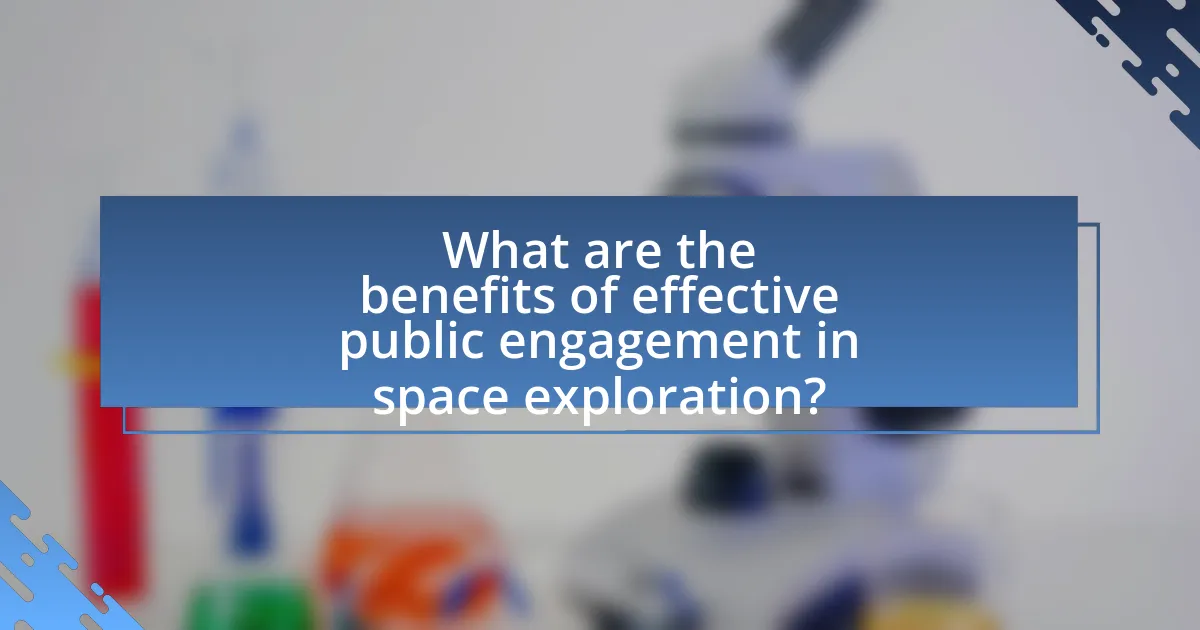
What are the benefits of effective public engagement in space exploration?
Effective public engagement in space exploration enhances scientific literacy and fosters public support for space initiatives. Engaging the public allows for a broader understanding of space science, which can lead to increased interest in STEM education and careers. For instance, NASA’s Artemis program has seen significant public interest due to its outreach efforts, resulting in a 20% increase in applications for related educational programs. Furthermore, public engagement can lead to increased funding and policy support, as demonstrated by the successful campaigns for funding increases in space agencies following public advocacy efforts. Overall, effective public engagement not only educates but also mobilizes community support, ultimately benefiting the advancement of space exploration.
How does public engagement foster collaboration between agencies and communities?
Public engagement fosters collaboration between agencies and communities by creating a platform for dialogue and shared decision-making. This interaction allows agencies to understand community needs and priorities, while communities gain insights into agency goals and processes. For instance, NASA’s public engagement initiatives, such as community workshops and online forums, have successfully gathered public input on space exploration projects, leading to more inclusive and relevant mission planning. This collaborative approach enhances trust, encourages resource sharing, and ultimately leads to more effective and sustainable outcomes in space exploration initiatives.
What partnerships can be formed through public engagement initiatives?
Public engagement initiatives can form partnerships between governmental agencies, educational institutions, non-profit organizations, and private sector companies. These collaborations enhance outreach efforts, foster innovation, and leverage resources for space exploration. For instance, NASA has partnered with universities to develop educational programs that inspire students in STEM fields, while also collaborating with private companies like SpaceX to advance technology and reduce costs in space missions. Such partnerships not only expand the reach of public engagement but also create a shared investment in the future of space exploration.
How does community involvement enhance mission outcomes?
Community involvement enhances mission outcomes by fostering collaboration, increasing public support, and leveraging diverse perspectives. Engaging the community allows organizations to tap into local knowledge and resources, which can lead to innovative solutions and improved project effectiveness. For instance, NASA’s Artemis program has seen increased public interest and participation through initiatives like the Artemis Moon Pod Challenge, which encourages students to contribute ideas for lunar exploration. This not only boosts enthusiasm but also cultivates a sense of ownership and responsibility among community members, ultimately leading to more successful mission outcomes.
What impact does public engagement have on future space exploration initiatives?
Public engagement significantly enhances future space exploration initiatives by fostering public interest, support, and funding. Engaged communities are more likely to advocate for space programs, as evidenced by the increased funding for NASA following successful public outreach campaigns, such as the Mars rover missions, which captured widespread media attention and public imagination. Furthermore, public involvement in citizen science projects, like Galaxy Zoo, has demonstrated that crowdsourced data can contribute valuable insights to scientific research, thereby directly impacting mission outcomes and priorities.
How can public feedback shape future mission designs?
Public feedback can significantly shape future mission designs by providing insights into public interests, concerns, and expectations. Engaging the public allows mission planners to align objectives with societal values, ensuring that missions are relevant and supported. For instance, NASA’s Mars 2020 mission incorporated public input through surveys and social media, which influenced the selection of scientific goals and outreach strategies. This approach not only enhances mission relevance but also fosters public trust and investment in space exploration initiatives.
What long-term benefits arise from sustained public interest in space exploration?
Sustained public interest in space exploration leads to long-term benefits such as increased funding for research and development, enhanced STEM education, and international collaboration. Increased funding is evidenced by NASA’s budget, which has grown from $16 billion in 2000 to over $23 billion in 2021, driven by public enthusiasm and advocacy. Enhanced STEM education results from initiatives like the Artemis program, which aims to inspire the next generation of scientists and engineers, as seen in the 2019 report by the National Academies of Sciences, Engineering, and Medicine that highlights the positive impact of space-related programs on student engagement. Additionally, international collaboration is exemplified by partnerships in the International Space Station, involving 15 nations, which fosters diplomatic relations and shared scientific goals. These factors collectively demonstrate that sustained public interest in space exploration yields significant long-term advantages.
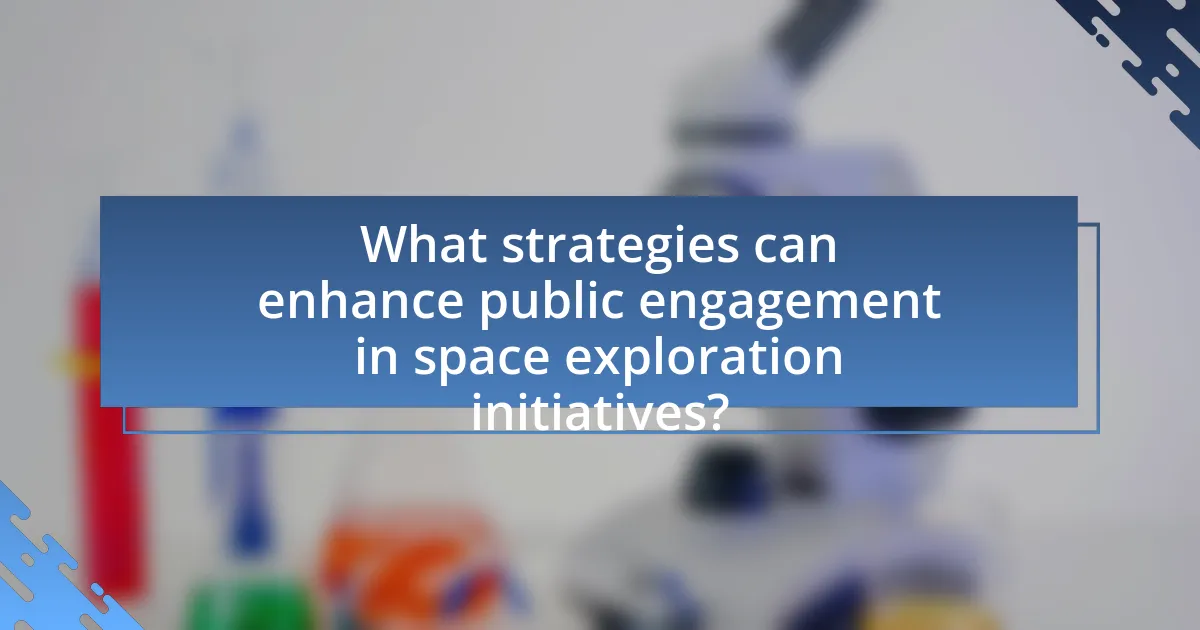
What strategies can enhance public engagement in space exploration initiatives?
To enhance public engagement in space exploration initiatives, organizations can implement interactive educational programs that foster curiosity and participation. For example, NASA’s “NASA’s Eyes on the Solar System” allows users to explore space missions in real-time, significantly increasing public interest and understanding. Additionally, hosting community events and workshops can create a direct connection between scientists and the public, as evidenced by the success of the “International Space Station” live Q&A sessions, which have attracted thousands of participants. Engaging social media campaigns that share real-time updates and behind-the-scenes content can also boost public involvement, as demonstrated by the high engagement rates on platforms like Twitter during major space events.
How can outreach programs be designed to maximize public participation?
Outreach programs can be designed to maximize public participation by incorporating interactive elements, utilizing diverse communication channels, and fostering community partnerships. Interactive elements, such as hands-on activities and live demonstrations, engage participants directly, making the experience more memorable and impactful. Utilizing diverse communication channels, including social media, local events, and educational institutions, ensures that outreach efforts reach a broader audience, catering to different demographics and preferences. Fostering community partnerships with local organizations and schools enhances credibility and encourages participation by leveraging existing networks. Research indicates that programs employing these strategies see increased engagement, as evidenced by the success of NASA’s “Mars Exploration Program,” which utilized interactive online platforms and community events to attract over 1 million participants in its outreach initiatives.
What role do interactive exhibits play in engaging the public?
Interactive exhibits play a crucial role in engaging the public by providing hands-on experiences that enhance learning and retention. These exhibits allow visitors to actively participate in the exploration of concepts, making complex scientific ideas more accessible and relatable. Research indicates that interactive learning can increase knowledge retention by up to 75%, compared to traditional passive learning methods. By fostering curiosity and encouraging exploration, interactive exhibits effectively bridge the gap between scientific knowledge and public interest, particularly in fields like space exploration.
How can citizen science projects involve the public in space research?
Citizen science projects can involve the public in space research by enabling individuals to contribute to data collection, analysis, and interpretation. For instance, platforms like Galaxy Zoo allow volunteers to classify galaxies from telescope images, directly engaging them in astronomical research. This approach not only democratizes scientific inquiry but also enhances data processing capabilities; studies show that citizen scientists can analyze vast amounts of data more efficiently than traditional methods. Furthermore, projects like SETI@home invite the public to assist in analyzing radio signals for extraterrestrial life, fostering a sense of community and shared purpose in scientific exploration.
What best practices should be followed for effective public engagement?
Effective public engagement requires clear communication, active listening, and inclusive participation. Clear communication ensures that information about space exploration initiatives is conveyed in an understandable manner, utilizing accessible language and various media formats. Active listening involves gathering feedback from the public to understand their concerns and interests, which can enhance trust and collaboration. Inclusive participation means involving diverse community members in the decision-making process, ensuring that different perspectives are represented. Research shows that initiatives with strong public engagement strategies, such as NASA’s “Citizen Science” projects, lead to increased public interest and support for space exploration, demonstrating the effectiveness of these best practices.
How can organizations measure the success of their public engagement efforts?
Organizations can measure the success of their public engagement efforts through metrics such as audience reach, engagement levels, and feedback quality. For instance, analyzing social media interactions, attendance at events, and survey responses provides quantitative and qualitative data on public interest and involvement. Research indicates that organizations that track these metrics can identify trends and areas for improvement, enhancing future engagement strategies. A study by the National Academy of Sciences highlights that effective public engagement in science, including space exploration, correlates with increased public understanding and support, demonstrating the importance of these measurement techniques.
What lessons can be learned from successful public engagement campaigns?
Successful public engagement campaigns demonstrate the importance of clear communication, audience understanding, and interactive participation. Clear communication ensures that messages are easily understood, as seen in NASA’s “Mars Rover” campaigns, which effectively used visuals and straightforward language to convey complex scientific concepts. Understanding the audience allows campaigns to tailor messages that resonate; for instance, the European Space Agency’s “Space for Kids” initiative engaged younger audiences by incorporating educational games and relatable content. Interactive participation fosters a sense of ownership and investment, exemplified by the “Name the Rover” campaign, where public involvement in naming the Mars rover increased interest and excitement. These lessons highlight that effective public engagement relies on clarity, audience awareness, and active involvement to foster enthusiasm and support for space exploration initiatives.
What are practical tips for individuals to engage with space exploration initiatives?
Individuals can engage with space exploration initiatives by participating in local astronomy clubs, attending public lectures, and volunteering for space-related organizations. Joining local astronomy clubs allows individuals to connect with like-minded enthusiasts and gain access to telescopes and educational resources. Attending public lectures hosted by universities or space agencies provides insights into current research and missions. Volunteering for organizations like NASA’s Citizen Science projects enables individuals to contribute to real scientific research, such as analyzing data from space missions. These activities not only enhance personal knowledge but also foster community involvement in space exploration.
